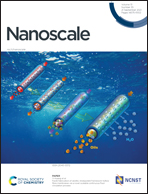Nanometallurgy in solution: organometallic synthesis of intermetallic Pd–Ga colloids and their activity in semi-hydrogenation catalysis†
Abstract
Nanoparticles (NPs) of Pd1−-xGax (x = 0.67, 0.5, 0.33), stabilized in non-aqueous colloidal solution, were obtained via an organometallic approach under mild conditions using [Pd2(dvds)3] and GaCp* as all-hydrocarbon ligated metal-precursor compounds (dvds = 1,1,3,3-tetramethyl-1,3-divinyl-disiloxane; Cp* = η5-C5Me5; Me = CH3). The reaction of the two precursors involves the formation of a library of molecular clusters [PdnGamCp*y(dvds)z], as shown by liquid injection field desorption ionization mass spectrometry (LIFDI-MS). Full characterization of the catalytic system (HR-TEM, EDX, DLS, PXRD, XPS, NMR, IR, Raman) confirmed the formation of ultra-small, spherical NPs with narrow size distributions ranging from 1.2 ± 0.2 nm to 2.1 ± 0.4 nm (depending on the Pd : Ga ratio). The catalytic performance of the Pd1−-xGax NPs in the semi-hydrogenation of terminal and internal alkynes and the influence of the gallium content on product selectivity were investigated. The highest activities (65%) and selectivities (81%) are achieved using colloids with a “stoichiometric” Pd/Ga ratio of 1 : 1 at 0 °C and 2.0 bar H2 pressure. While lower Ga ratios lead to an increase in activity, higher Ga contents increase the olefin selectivity but are detrimental to the activity.



 Please wait while we load your content...
Please wait while we load your content...